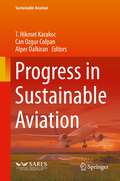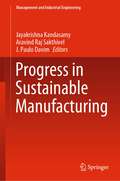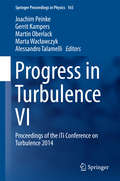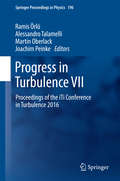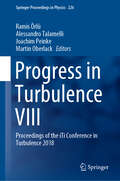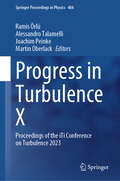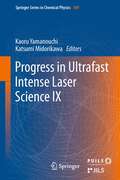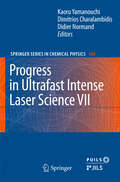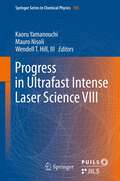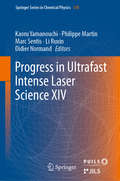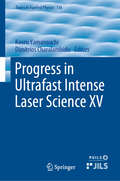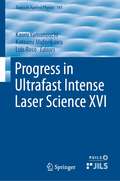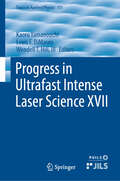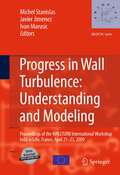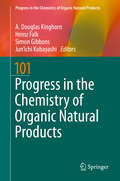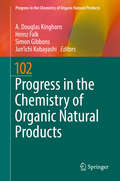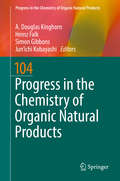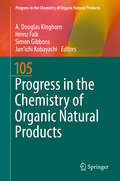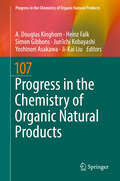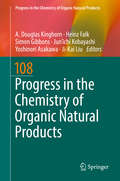- Table View
- List View
Progress in Sustainable Aviation (Sustainable Aviation)
by T. Hikmet Karakoc Can Ozgur Colpan Alper DalkiranProgress in Sustainable Aviation looks at recent progress and new technological developments in sustainable aviation, presenting readers with engineering solutions and methodologies for efficiency and cost savings, performance improvement, and emission reduction. Coverage includes alternative fuel types, propulsion technologies, and emission technologies used in different aerial vehicles, such as unmanned aerial vehicles, drones, and passenger aircraft. Operational areas, such as the building of green airports, commercial air transport, and maintenance management are also addressed. This collection will be a valuable reference for researchers, practicing engineers, scientists, and students working in the area of sustainable aviation technology and management. Looks at recent progress in sustainable aviation technologies;Presents alternative aviation fuel types and propulsion technologies;Includes case studies and practical applications.
Progress in Sustainable Manufacturing (Management and Industrial Engineering)
by J. Paulo Davim Aravind Raj Sakthivel Jayakrishna KandasamyThis book provides recent developments in sustainable manufacturing ranging from product designing to product delivery. It focuses on key challenges and solutions at various stages such as product design, material selection, material processing, manufacturing and energy consumption to ensure sustainability at every stage of product lifecycle. It further offers solutions to build sustainable product by responsible consumption and production. The role of advanced technologies in sustainable manufacturing is also covered in this book. Given the topics covered, this book will be useful for the researchers and professionals working in the area of mechanical engineering, especially industrial and production engineering.
Progress in Theology: Does the Queen of the Sciences Advance? (Routledge Science and Religion Series)
by Rik Peels Gijsbert van den Brink Bethany SollerederThis book explores the intriguing relationship between theology, science, and the ideal of progress from a variety of perspectives. While seriously discussing the obstacles and pitfalls related to the notion of progress in theology, it argues that there are in fact many different kinds of progress in theology. It considers how this sheds positive light on what theologians do and suggests that other disciplines in the humanities can equally profit from these ideas. The chapters provide tools for making further progress in theology, featuring detailed case studies to show how progress in theology works in practice and connecting with the role and place of theology in the University. The book rearticulates in multiple ways theology’s distinctive voice at the interface of science and religion.
Progress in Turbulence VI
by Joachim Peinke Gerrit Kampers Martin Oberlack Marta Wacławczyk Alessandro TalamelliThis volume collects the edited and reviewedcontributions presented in the 6th iTi Conference in Bertinoro, coveringfundamental and applied aspects in turbulence. In the spirit of the iTiconference, the volume has been produced after the conference so that theauthors had the possibility to incorporate comments and discussions raisedduring the meeting. In the present book the contributions have been structuredaccording to the topics : I Theory II Wall bounded flows III Particles in flows IV Free flows V Complex flows The volume is dedicated to the memory of Prof. KonradBajer who prematurely passed away in Warsaw on August 29, 2014.
Progress in Turbulence VII
by Joachim Peinke Martin Oberlack Alessandro Talamelli Ramis ÖrlüThis volume collects the edited and reviewed contribution presented in the 7th iTi Conference in Bertinoro, covering fundamental and applied aspects in turbulence. In the spirit of the iTi conference, the volume is produced after the conference so that the authors had the opportunity to incorporate comments and discussions raised during the meeting. In the present book, the contributions have been structured according to the topics: I Theory II Wall bounded flows III Pipe flow IV Modelling V Experiments VII Miscellaneous topics
Progress in Turbulence VIII: Proceedings of the iTi Conference in Turbulence 2018 (Springer Proceedings in Physics #226)
by Joachim Peinke Martin Oberlack Alessandro Talamelli Ramis ÖrlüThis volume collects the edited and reviewed contributions presented in the 8th iTi Conference on Turbulence, held in Bertinoro, Italy, in September 2018. In keeping with the spirit of the conference, the book was produced afterwards, so that the authors had the opportunity to incorporate comments and discussions raised during the event. The respective contributions, which address both fundamental and applied aspects of turbulence, have been structured according to the following main topics: I TheoryII Wall-bounded flowsIII Simulations and modellingIV ExperimentsV Miscellaneous topicsVI Wind energy
Progress in Turbulence X: Proceedings of the iTi Conference on Turbulence 2023 (Springer Proceedings in Physics #404)
by Joachim Peinke Martin Oberlack Alessandro Talamelli Ramis ÖrlüThis book collects the edited and reviewed contribution presented in the 10th iTi conference in Bertinoro, covering fundamental and applied aspects in turbulence. In the spirit of the iTi conference, the book is produced after the conference so that the authors had the opportunity to incorporate comments and discussions raised during the meeting. The iTi has become an established biannual conference on turbulence research with 80 to 100 participants and places value on creating an environment to stimulate discussions and personal contacts in the beautiful town of Bertinoro in Northern Italy close to Bologna, continuing a tradition that has started in Bad Zwischenahn/Germany with the first edition of the conference in 2003. The content-related focus areas of the conference are the interdisciplinary aspects of turbulence, defining the abbreviation iTi—interdisciplinary turbulence initiative. iTi attracts scientist from the engineering, physics, and mathematics communities.
Progress in Ultrafast Intense Laser Science
by Kaoru Yamanouchi Katsumi MidorikawaThe PUILS series delivers up-to-date reviews of progress in Ultrafast Intense Laser Science, a newly emerging interdisciplinary research field spanning atomic and molecular physics, molecular science, and optical science, which has been stimulated by the recent developments in ultrafast laser technologies. Each volume compiles peer-reviewed articles authored by researchers at the forefront of each their own subfields of UILS. Every chapter opens with an overview of the topics to be discussed, so that researchers unfamiliar to the subfield, as well as graduate students, can grasp the importance and attractions of the research topic at hand; these are followed by reports of cutting-edge discoveries. This ninth volume covers a broad range of topics from this interdisciplinary research field, focusing on ultrafast molecular responses to an intense laser field, advanced techniques for attosecond pulse generation, atomic and molecular responses to attosecond pulses, photoelectron spectroscopy of atoms and molecules interacting with intense light fields, and attosecond pulse interaction with solid materials.
Progress in Ultrafast Intense Laser Science VII
by Kaoru Yamanouchi Dimitrios Charalambidis Didier NormandThe PUILS series delivers up-to-date reviews of progress in Ultrafast Intense Laser Science, a newly emerging interdisciplinary research field spanning atomic and molecular physics, molecular science, and optical science, which has been stimulated by the recent developments in ultrafast laser technologies. Each volume compiles peer-reviewed chapters authored by researchers at the forefront of each their own subfields of UILS. Every chapter begins with an overview of the topics to be discussed, so that researchers unfamiliar to the subfield, as well as graduate students, can grasp the importance and attractions of the research topic at hand; these are followed by reports of cutting-edge discoveries. This seventh volume covers a broad range of topics from this interdisciplinary research field, focusing on the ionization of atoms and molecules, ultrafast responses of protons and electrons within a molecule, molecular alignment, high-order harmonics and attosecond pulse generation, and acceleration of electrons and ions in laser plasmas.
Progress in Ultrafast Intense Laser Science VII (Springer Series in Chemical Physics #100)
by Kaoru Yamanouchi Dimitrios Charalambidis Didier NormandThe PUILS series delivers up-to-date reviews of progress in Ultrafast Intense Laser Science, a newly emerging interdisciplinary research field spanning atomic and molecular physics, molecular science, and optical science, which has been stimulated by the recent developments in ultrafast laser technologies. Each volume compiles peer-reviewed chapters authored by researchers at the forefront of each their own subfields of UILS. Every chapter begins with an overview of the topics to be discussed, so that researchers unfamiliar to the subfield, as well as graduate students, can grasp the importance and attractions of the research topic at hand; these are followed by reports of cutting-edge discoveries. This seventh volume covers a broad range of topics from this interdisciplinary research field, focusing on the ionization of atoms and molecules, ultrafast responses of protons and electrons within a molecule, molecular alignment, high-order harmonics and attosecond pulse generation, and acceleration of electrons and ions in laser plasmas.
Progress in Ultrafast Intense Laser Science VIII
by Kaoru Yamanouchi Mauro Nisoli Wendell T. Hill IIIThe PUILS series delivers up-to-date reviews of progress in Ultrafast Intense Laser Science, a newly emerging interdisciplinary research field spanning atomic and molecular physics, molecular science and optical science which has been stimulated by the recent developments in ultrafast laser technologies. Each volume compiles peer-reviewed articles authored by researchers at the forefront of each their own subfields of UILS. Every chapter opens with an overview of the topics to be discussed, so that researchers unfamiliar to the subfield as well as graduate students can grasp the importance and attractions of the research topic at hand. These are followed by reports of cutting-edge discoveries. This eighth volume covers a broad range of topics from this interdisciplinary research field, focusing on molecules interacting with ultrashort and intense laser fields, advanced technologies for the characterization of ultrashort laser pulses and their applications, laser plasma formation and laser acceleration.
Progress in Ultrafast Intense Laser Science XIV (Springer Series in Chemical Physics #118)
by Philippe Martin Kaoru Yamanouchi Didier Normand Marc Sentis Li RuxinThis 14th volume in the PUILS series presents up-to-date reviews of advances in Ultrafast Intense Laser Science, an interdisciplinary research field spanning atomic and molecular physics, molecular science, and optical science, which has been stimulated by the rapid developments in ultrafast laser technologies. Each chapter begins with an overview of the topics to be discussed, so that researchers unfamiliar to the subfield, as well as graduate students, can grasp the importance and appeal of the respective subject matter; this is followed by reports on cutting-edge discoveries. This volume covers a broad range of topics from this interdisciplinary field, e.g. atoms and molecules interacting in intense laser fields, laser-induced filamentation, high-order harmonics generation, and high-intensity lasers and their applications.
Progress in Ultrafast Intense Laser Science XV (Topics in Applied Physics #136)
by Kaoru Yamanouchi Dimitrios CharalambidisThis book covers a diverse cross section of this interdisciplinary research field, with contributions grouped into four categories: laser-induced filamentation; atoms and molecules in a laser field; interaction of solid materials with a coherent light field; and ion acceleration and ionization of atoms in super intense laser fields.This book series presents up-to-date reviews of advances in this interdisciplinary research field, spanning atomic and molecular physics, as well as molecular and optical science, which have been stimulated by the recent developments in ultrafast laser technologies. Each book compiles peer-reviewed articles by researchers at the forefront of their particular subfields. All the chapters include an overview to allow graduate students and researchers unfamiliar with the subfield to grasp the importance and attractions of the topic covered, followed by reports of cutting-edge discoveries.
Progress in Ultrafast Intense Laser Science XVI (Topics in Applied Physics #141)
by Kaoru Yamanouchi Luis Roso Katsumi MidorikawaThis book covers a broad range of topics from the interdisciplinary research field of ultrafast intense laser science, focusing on atoms and molecules interacting with intense laser fields, laser-induced filamentation, high-order harmonics generation, and high power lasers and their applications. This sixteenth volume features contributions from world-renowned researchers, introducing the latest reports on probing molecular chirality with intense laser fields, and the most recent developments in the Shanghai Superintense Ultrafast Laser Facility project.The PUILS series delivers up-to-date reviews of progress in this emerging interdisciplinary research field, spanning atomic and molecular physics, molecular science, and optical science, which has been stimulated by the recent developments in ultrafast laser technologies. Each volume compiles peer-reviewed articles authored by researchers at the forefront of each of their own subfields of ultrafast intense laser science. Every chapter opens with an overview of the topics to be discussed, so that researchers unfamiliar to the subfield, especially graduate students, can grasp the importance and attractions of the research topic at hand; these are followed by reports of cutting-edge discoveries.
Progress in Ultrafast Intense Laser Science XVII (Topics in Applied Physics #151)
by Kaoru Yamanouchi Wendell T. Hill III Louis F. DiMauroThis book covers a broad range of interdisciplinary topics, focusing on atoms and molecules in intense laser fields, excitation processes in intense laser fields, photonics and materials, high-order harmonics generation, XFEL, high-power lasers and their applications, and quantum computing. This seventeenth volume features contributions from world-renowned researchers on topics such as applications of attosecond and femtosecond laser pulses, coherence and dynamics in quantum systems, and applications of super-intense laser fields.The PUILS series delivers up-to-date reviews of progress in this emerging interdisciplinary research field, spanning atomic and molecular physics, molecular science, and optical science, which has been stimulated by the recent developments in ultrafast laser technologies. Each volume compiles peer-reviewed articles authored by researchers at the forefront of each of their own subfields of ultrafast intense laser science. Every chapter opens with an overview of the topics to be discussed, so that researchers unfamiliar with the subfield, especially graduate students, can grasp the importance and attractions of the research topic at hand; these are followed by reports of cutting-edge discoveries.
Progress in Vehicle Aerodynamics and Thermal Management: 11th Fkfs Conference, Stuttgart, September 26-27 2017
by Jochen WiedemannThe books presents latest information about new car developments, new or improved testing techniques and new or improved calculation procedures. Presenters are from industry and academia.
Progress in Wall Turbulence 2
by Ivan Marusic Javier Jimenez Michel StanislasThis is the proceedings of the ERCOFTAC Workshop on Progress in Wall Turbulence: Understanding and Modelling, that was held in Lille, France from June 18 to 20, 2014. The workshop brought together world specialists of near wall turbulence and stimulated exchanges between them around up-to-date theories, experiments, simulations and numerical models. This book contains a coherent collection of recent results on near wall turbulence including theory, new experiments, DNS and modeling with RANS, LES. The fact that both physical understanding and modeling by different approaches are addressed by the best specialists in a single workshop is original.
Progress in Wall Turbulence: Proceedings of the WALLTURB International Workshop held in Lille, France, April 21-23, 2009
by Ivan Marusic Javier Jimenez Michel StanislasThis book will consist of a coherent collection of recent results on near wall turbulence including theory, new experiments, DNS, and modeling with RANS, LES and Low Order Dynamical Systems.
Progress in the Chemistry of Organic Natural Products 100
by H. Falk J. Kobayashi A. D. KinghornThe volumes of this classic series, now referred to simply as "Zechmeister" after its founder, L. Zechmeister, have appeared under the Springer Imprint ever since the series' inauguration in 1938. It is therefore not really surprising to find out that the list of contributing authors, who were awarded a Nobel Prize, is quite long: Kurt Alder, Derek H. R. Barton, George Wells Beadle, Dorothy Crowfoot-Hodgkin, Otto Diels, Hans von Euler-Chelpin, Paul Karrer, Luis Federico Leloir, Linus Pauling, Vladimir Prelog, with Walter Norman Haworth and Adolf F. J. Butenandt serving as members of the editorial board. The volumes contain contributions on various topics related to the origin, distribution, chemistry, synthesis, biochemistry, function or use of various classes of naturally occurring substances ranging from small molecules to biopolymers. Each contribution is written by a recognized authority in his field and provides a comprehensive and up-to-date review of the topic in question. Addressed to biologists, technologists and chemists alike, the series can be used by the expert as a source of information and literature citations and by the non-expert as a means of orientation in a rapidly developing discipline.
Progress in the Chemistry of Organic Natural Products 101
by A. Douglas Kinghorn Heinz Falk Simon Gibbons Jun'Ichi KobayashiThe volumes of this classic series, now referred to simply as "Zechmeister" after its founder, Laszlo Zechmeister, have appeared under the Springer Imprint ever since the series' inauguration in 1938. The series has featured contributions by seven Nobel laureates: D. H. R. Barton, D. Crowfoot Hodgkin, L. Pauling, K. Alder, O. Diels, P. Karrer, and H. von Euler-Chelpin. The volumes contain contributions on various topics related to the origin, distribution, chemistry, synthesis, biochemistry, function or use of various classes of naturally occurring substances ranging from small molecules to biopolymers. Each contribution is written by a recognized authority in the field and provides a comprehensive and up-to-date review of the topic in question. Addressed to biologists, technologists, and chemists alike, the series can be used by the expert as a source of information and literature citations and by the non-expert as a means of orientation in a rapidly developing discipline.
Progress in the Chemistry of Organic Natural Products 102
by Heinz Falk A. Douglas Douglas Kinghorn Simon Gibbons Jun'Ichi KobayashiThe first contribution reviews the phytochemical, chemical,and biological literature on members of the ingenane class of diterpenoids fromtheir first isolation in 1968 through 2015, highlighting unresolved issues bothcommon to phorboids and specific to ingenol derivatives. The biogenesis of ingenol is discussed in thelight of the Jakupovic proposal of a dissection between the formation of the macrocyclicEuphorbia diterpenoids and the phorboids,and the clinical development of ingenol mebutate is chronicled in the light ofits "reverse-pharmacology" focus. The second contributionoffers a comprehensive view of the chemical wealth and the taxonomic problemscurrently impeding chemical and biological investigations of the genus Laurencia. It addresses the botanical description and the growth andpopulation dynamics of the genus, as well as its chemical diversity and ecologicalrelations; the secondary metabolites as well as their sources of isolation; and finally the biological activity.
Progress in the Chemistry of Organic Natural Products 104 (Progress in the Chemistry of Organic Natural Products #104)
by A. Douglas Kinghorn Heinz Falk Simon Gibbons Jun'Ichi KobayashiThe first contribution describes apolar and polar molecular fossils and, in particular biomarkers, along the lines usually followed in organic chemistry textbooks, and points to their bioprecursors when available. Thus, the apolar compounds are divided in linear and branched alkanes followed by alicyclic compounds and aromatic and heterocyclic molecules, and, in particular, the geoporphyrins. The polar molecular fossils contain as functional groups or constituent units ethers, alcohols, phenols, carbonyl groups, flavonoids, quinones, and acids, or are polymers like kerogen, amber, melanin, proteins, or nucleic acids. The final sections discuss the methodology used and the fundamental processes encountered by the biomolecules described, including diagenesis, catagenesis, and metagenesis. The second contribution covers the distribution of phthalides in nature and the findings in the structural diversity, chemical reactivity, biotransformations, syntheses, and bioactivity of natural and semisynthetic phthalides.
Progress in the Chemistry of Organic Natural Products 105
by A. Douglas Kinghorn Heinz Falk Simon Gibbons Jun'Ichi KobayashiThe first contribution reviews the occurrence of xanthine alkaloids in the plant kingdom and the elucidation of the caffeine biosynthesis pathway, providing details of the N-methyltransferases, belonging to the motif B' methyltransferase family which catalyze three steps in the four step pathway leading from xanthosine to caffeine. The second contribution in this book provides a background on the molecule and related compounds and update knowledge on the most recent advances in Iboga alkaloids. The third contribution presents a comprehensive analysis of frequently occurring errors with respect to 13C NMR spectroscopic data and proposes a straightforward protocol to eliminate a high percentage of the most obvious errors.
Progress in the Chemistry of Organic Natural Products 107 (Progress in the Chemistry of Organic Natural Products #107)
by A. Douglas Kinghorn Heinz Falk Simon Gibbons Jun'Ichi Kobayashi Yoshinori Asakawa Ji-Kai LiuThe first review describes examples of very promising compounds discovered from plants acquired from Africa, Southeast Asia, the Americas, and the Caribbean region with potential anticancer activity. These include plant secondary metabolites of the diphyllin lignan, penta[b]benzofuran, triterpenoid, and tropane alkaloid types. The second review presents 40 more erythrinan alkaloids, which were either new or were missed out in the last major reviews, bringing to a total of 154 known erythrinan alkaloids known to date. The reported pharmacological activities of the new and known alkaloids showed a greater bias towards central nervous system and related activities. Other prominent activities reported were antifeedant or insecticidal, cytotoxicity/antitumor/anticancer/estrogenic, antiprotozoal, antiinflammatory, antioxidant, antifungal and antiviral activities.
Progress in the Chemistry of Organic Natural Products 108 (Progress in the Chemistry of Organic Natural Products #108)
by A. Douglas Kinghorn Heinz Falk Simon Gibbons Jun'Ichi Kobayashi Yoshinori Asakawa Ji-Kai LiuThe first contribution summarizes current trends in research on medicinal plants in Mexico with emphasis on work carried out at the authors' laboratories. The most relevant phytochemical and pharmacological profiles of a selected group of plants used widely for treating major national health problems are described. The second contribution provides a detailed survey of the so far reported literature data on the capacities of selected oxyprenylated phenylpropanoids and polyketides to trigger receptors, enzymes, and other types of cellular factors for which they exhibit a high degree of affinity and therefore evoke specifice responses. And the third contribution discusses aspects of endophytic actinobacterial biology and chemistry, including biosynthesis and total synthesis of secondary metabolites produced in culture. It also presents perspectives fo the future of microbial biodiscovery, with emphasis on the seondary metabolism of endophytic actinobacteria.
